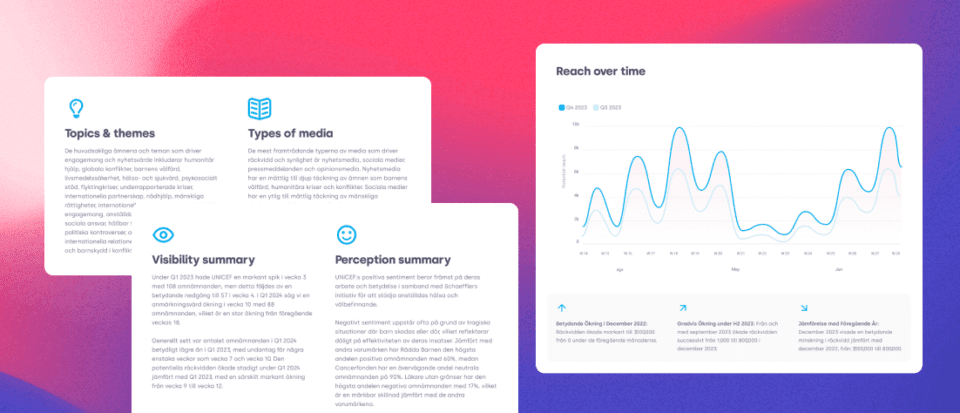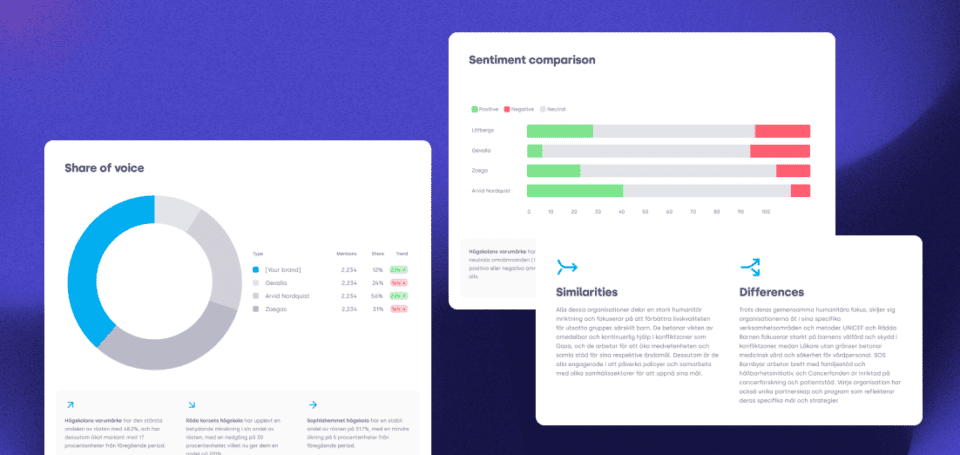Brand Report – How to Report on Brand Performance

What is a good brand reputation worth? And what is the value of earned brand impressions compared to the value of paid ads? With today’s clever, AI-based reporting tools, you can leverage thousands of data points to automatically measure and report these numbers in a way that’s understandable and actionable. Here’s how you can deliver a solid brand performance report for your management.
Marketing and Sales.
A special relationship that has built brands for centuries.
For most of this time, we PR and marketing professionals have struggled to measure the true value of what we bring to the table.
The monetary value of long-term, indirect results such as trust and brand reputation is not as easy to measure as the value of a closed sales deal. Yet, everyone knows that word of mouth has always been the best medium.
So, how do we measure it?
When Bill Bernbach, founder of the global advertising agency DDB, said:
Nobody counts the number of ads you run; they just remember the impression you make
… how did he measure that impression?
Thanks to better tools and smarter AI, we can now create easy-to-understand, actionable brand reports that consolidate these metrics in seconds, using the same ROI language that management teams and stakeholders do.
Here’s how to create an insightful brand report to present to your organization.
What to Include in a Brand Report
First of all, a proper brand report should:
- Highlight key metrics related to brand performance.
- Be delivered regularly: monthly, quarterly, and/or annually.
- Include historical data and competitor benchmarking.
- Provide actionable insights from analyzing these numbers.
When it comes to metrics, a brand report should include results for:
- Brand Awareness
- Brand Reputation
- Share of Voice
As a PR and marketing professional, you’re well aware that people bragging about your brand (word of mouth) is way more valuable than bragging about yourself (advertising).
In report metrics, this translates into measuring reach and impressions, and whether the impact and buzz are positive or negative.
It also includes benchmarking your brand against your competitors. Maybe you had great reach during Q1, but maybe your competitor did, too, because of seasonal variables.
More specifically, your brand report should measure the following:
- Brand Awareness: Visibility through distribution, reach, and impact of mentions in the media over time.
- Brand Reputation: Sentiment analysis – if your brand is mentioned in a positive, negative, or neutral context.
- Share of Voice: Your media mentions and share of mentions over time, compared to your competitors.
Now, let’s look at what those metrics say.
How to Measure and Report on Brand Awareness
Measuring your brand awareness is essentially about quantifying your brand’s presence in the public domain to see whether your brand is gaining or losing visibility.
This is measured by analyzing the distribution and impact of mentions in the media.
It should include mentions, total reach, media reach, and social media reach over time to showcase visibility trends and highlight growth or decline.
Our Brand Report tool also translates mentions and reach into monetary value. It automatically estimates the corresponding paid ad value of your PR efforts. Of course, there are various ways to do this.

How to Measure and Report on Brand Reputation
Your brand report should provide insight into your brand reputation – how your brand is perceived by the public.
This can be presented as an overall sentiment score, where brand mentions are categorized as positive, neutral, or negative. The sentiment score indicates the public opinion of your brand and the emotional tone behind these opinions.
Over time, this metric shows the change in brand perception.

How to Measure and Report on Share of Voice (SoV)
Finally, your brand report should show your brand’s position in the market.
A key metric for measuring this is the Share of Voice. It compares your brand’s market visibility against competitors and measures how much conversation your brand garners from the total conversion in your industry across various media.
Simply put, it measures brand popularity and market presence.
The higher the SoV, the more people talk about your brand, and the stronger its position as a trusted authority.
In our Brand Report, for example, this is calculated and analyzed automatically. Again, there are many ways to do it. You have to find a solution or method that you feel works for you.
Conclusion
The metrics we recommend in this blog post are:
- Brand Awareness: Visibility through distribution, reach, and impact of mentions in the media over time.
- Brand Reputation: Sentiment analysis – if your brand is mentioned in a positive, negative, or neutral context.
- Share of Voice: Your media mentions and share of mentions over time, compared to your competitors.
There are various tools and software for measuring these metrics and compiling easy-to-read, nice-looking brand reports. One such tool is Brand Report.
And the next time someone questions the value of your PR and branding efforts, remind them that you do not create leads.
You create trust.
Which generates more and better leads over time than any paid ad or sales call.